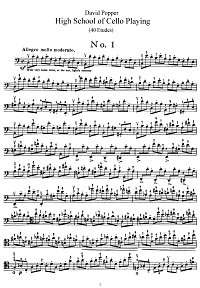|
Popper - 40 Etudes for cello - High school of cello playing
Popper - 40 Etudes for cello - High school of cello playing. You can download the sheet music Popper - 40 Etudes for cello - High school of cello playing on this page. The forty studies that David Popper gathered together in his High School of Violoncello Playing ("Hohe Schule des Violoncellospiels", op. 73) have remained to the present day the standard collection of etudes for learning the cello. Even among currently available etude collections they occupy a special position, for each etude is specifically devoted to one or a particular combination of technical difficulties. No other collection so rigorously maintains this methodological approach; even Alfredo Piatti's terse Capriccios have a few exceptions in this respect, not to mention the multi-page etudes of Friedrich Grutzmacher, which invariably string together several completely contrasting sections. Popper's High School of Violoncello Playing is the only collection of studies equally deserving of the terms "school" and "etude". Most of the pieces cannot possibly be played well without a full mastery of the particular technical problem involved. It is this consistency of focus that constitutes the collection's uniqueness and its present-day relevance.
To download PDF, click the "Download PDF" button below the appropriate sheet music image.
To view the first page of Popper - 40 Etudes for cello - High school of cello playing click the music sheet image. |
| PDF format sheet music |
|
|
|
Cello part: 86 pages. 6804 K
|
|
 |
|
|
|
| Download PDF (14.99
€) |
|
|
|
Authors also explain many of the changes we have made to Popper's original fingering and/or bowing marks. In most cases we reproduce Popper's original markings. A glance at Popper's career suggests that he retained an interest in new challenges and the musical developments of his day until late in life. The very fact that he recognized the need for a new collection of studies to meet musical demands is proof enough. Considering that the bulk of the present-day cello repertoire had not even been composed, the unique and lasting relevance of his collection is all the more impressive from today's perspective. Of course recent decades have witnessed further developments in our instrument, its playing techniques, the demands on cellists of every age and even the general level of performance. Unlike Popper's day, when only the greatest cellists were capable of playing the Haydn, Schumann or Dvorak concertos outstandingly (and certainly no worse than today's soloists), nowadays almost every student is expected to do so. Many leading cellists and teachers have pondered the problems of fingering and bowing technique, just as violinists and pianists had done a hundred years earlier. Schools of cello playing have emerged; indeed, as far as sheer quantity is concerned, no longer do cellists represent an exotic minority in the world of music.
Having come into being over several years, the forty etudes are not arranged systematically in progressive order of difficulty, and the order in which they can be practiced is thus more or less arbitrary. Thematic relations are discernible only in the first ten etudes, e. g. in Nos. 2 through 4 and 8 through 10. The majority of the more complex etudes are found, as might be expected, in the second half of the collection, although Nos. 9, 12 and 13 are among the most difficult in the entire opus. In short, the pupil (or teacher) should make his or her selection according to the degree of difficulty or the problem confronted rather than proceeding in numerical order. Generally speaking, most of the etudes are devoted to problems of the left hand, so that it is perhaps advisable for students to supplement the High School with, say, Otakar Sevcik's Forty Variations, op. 3.
The commentary below illuminates the difficulty involved in each etude and facilitates its mastery by providing suggestions for practicing. It goes without saying that each of these technical aids and instructions, rather than representing the only valid solution, is merely one alternative among many. Owing to the great variety of methods that have grown over the last two centuries, the present editor too bears the hallmarks and influences of one or more of them. The terms "right" and "wrong" are difficult to define in this context, even if something may appear "right" or "wrong" within an overall system of cello technique or musical aesthetic. None the less, what is "wrong" to one person may be "right" to another, and vice versa. Learners are therefore advised to set out on the suggested pathways in difficult or imperfectly mastered passages and only then to decide whether they represent a viable solution to the problem at hand. |
|